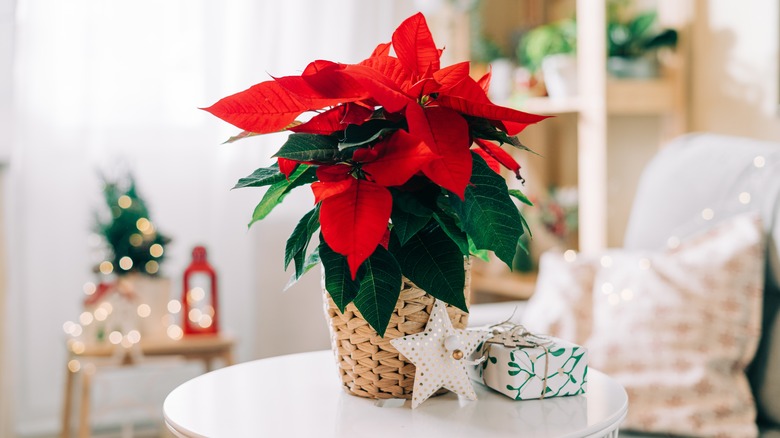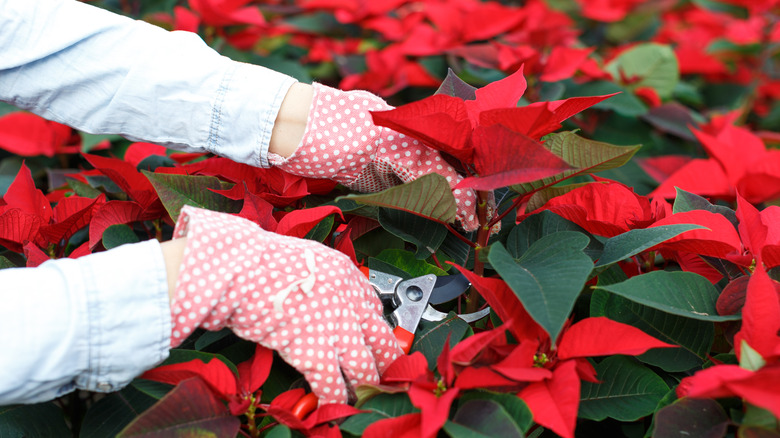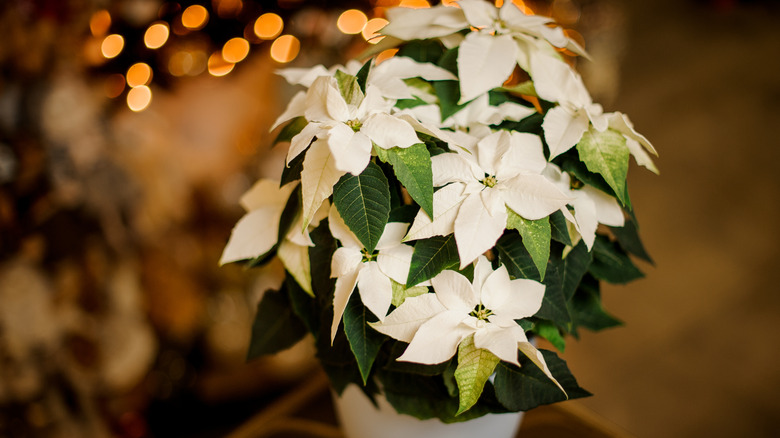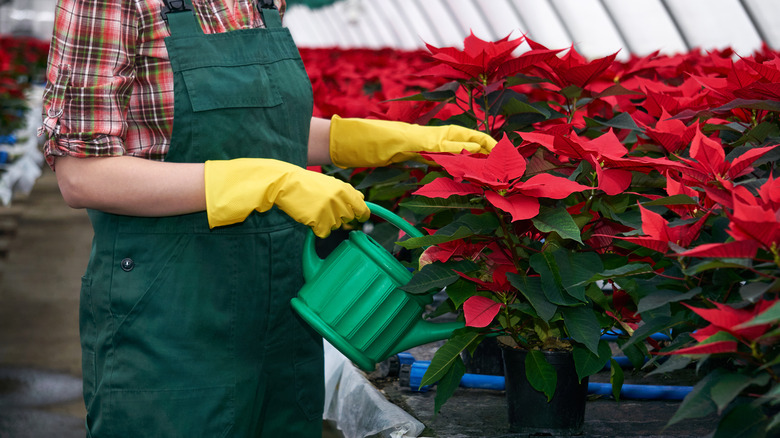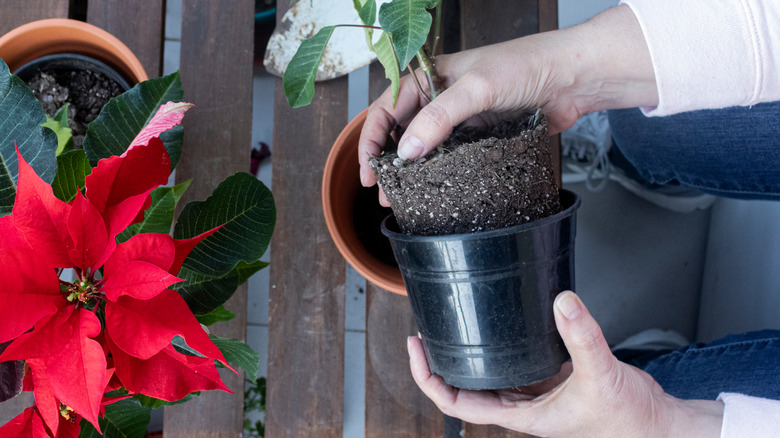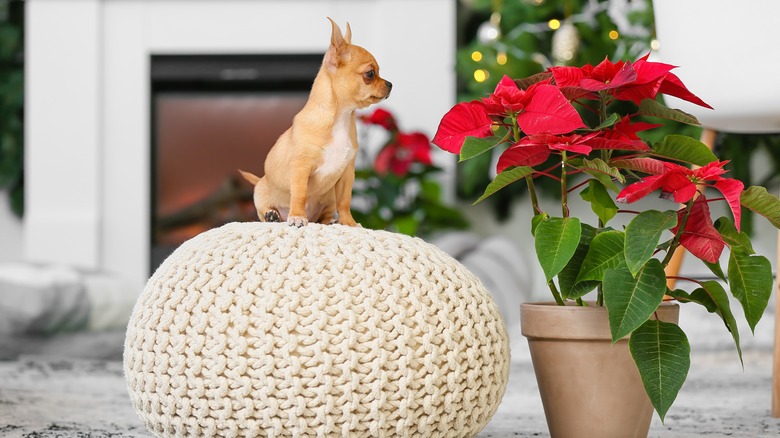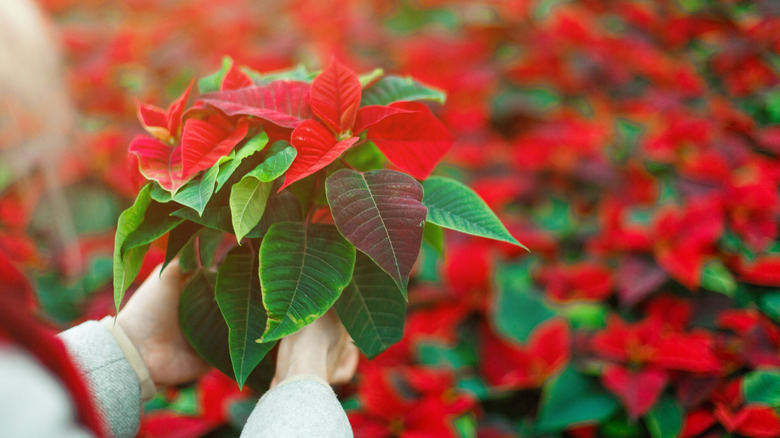How To Make Sure Your Poinsettia Survives After Christmas
Euphorbia Pulcherrima, most commonly known as Poinsettia, is often given as a gift during the winter holiday season. Poinsettias may be beautiful when they bloom in December, but there is a lot of work needed for them to bloom. As a plant that is native to Mexico and Central America, poinsettias thrive in a humid environment with bright light, according to The Spruce. Poinsettias are actually a shrub, although the commercialized version of this plant is never allowed to grow past being a houseplant. They measure 3 to 10 feet high and 3 to 7 feet wide. Their flowers are forced to bloom in time for the holiday season, so it is not recommended for beginners if they expect their poinsettia to bloom again the next year.
There are over 100 varieties of poinsettias, the most common being Prestigious Red (via Illinois University). Poinsettias come in a variety of colors, too; red is the staple flower color for poinsettias but other varieties have pink, white, cream, salmon, and yellow blooms. The names of these are Premium Picasso, Monet Twilight, Shimmer, and Surprise.
How to use poinsettias in garden
Poinsettias are native to Mexico and Central America as a type of scrub. If you're looking to plant your poinsettia outside, there are a couple of requirements. First, you need to live in an area that doesn't freeze or snow, with the coldest nights being 60 degrees Fahrenheit. Secondly, if you want your poinsettia to bloom in December, it needs to be planted in an area that is completely dark for 12 hours of the day. You can also use a box to cover your poinsettia every night.
During their blooming period, poinsettias are a great way to add a pop of color to your garden, but during the other 11 months of the year, it is a leafy green shrub with red stems. If you want to keep your poinsettia looking similar to how it did in the nursery pot when you bought it, you'll need to trim it in May and pinch its branches in the summer. Otherwise, poinsettias can grow into leggy trees from 10 to 15 feet tall, according to HGTV.
How to grow poinsettias
Poinsettias can be grown from a seed or a cutting. It's also important to make sure you are using a pot with drainage holes because poinsettias are especially prone to root rot; this includes removing the plastic wrapping if you received it as a gift or got it from a store. To grow a poinsettia from seed you will need to sow them in a pot of dirt. The dirt should be kept moist, warm, and in bright sunlight. After a couple of weeks, the seedlings will have sprouted.
To grow a poinsettia from a cutting, you will, of course, first need to get a cutting. From a healthy plant, take a 3 to 6 inch cutting of a healthy stem. Using rooting hormone will help promote root growth. The cutting can then be placed into a pot of moist soil or sand. Putting saran wrap or a plastic bag over the pot will act as a greenhouse, keeping the humidity and warmth inside, according to Gardening Know How. After a month, your poinsettia will have developed a healthy root system.
How to care for poinsettias
Poinsettias are not for beginners if you want them to live and bloom past the holiday season. They require full sun, but this needs to be filtered, or else the leaves will burn. You can filter bright sunlight by putting a sheer curtain on your windows. Poinsettias also need to be watered about once a week. What you should be looking for is if the soil feels dry to the touch by putting your finger about an inch into the soil. You don't want your poinsettia to be soaking wet, but the soil should be moist. Note that watering too often is the most common reason for poinsettias to die. Signs that your plant has root rot are that the leaves are turning yellow and falling off and the stems are black or brown. The best way to deal with root rot is to cut off any dead roots and repot your plant in well-draining soil.
Because poinsettias are native to Mexico and Central America they need a warm humid environment. Most people don't realize this because poinsettias are seen as winter plants. They do best indoors from 55 to 75 degrees Fahrenheit, according to Better Homes & Gardens. If you have the heating on in your house it's also a good idea to invest in a humidifier because poinsettias need humidity. When deciding where to place your poinsettia, keep it away from drafts, like cold air coming in through a window.
How to re-pot poinsettias
The best time to re-pot your poinsettia is in May. If you are following the blooming schedule, this is also the time of year when you will trim back your poinsettia to prepare it for growth during the summer. When looking for a new pot, the two biggest requirements other than aesthetics are that it should have drainage holes and be 2 to 4 inches larger than your poinsettia's current pot.
The best potting mix for poinsettias is a well-draining potting mix with peat moss, according to Gardening Know How. This is because poinsettias are susceptible to over-watering and root rot. Before moving your poinsettia into its new pot, always tease the roots so that it can easily grow into its new pot. Re-pot your poinsettia at the same dirt level that it was in the old pot and water it thoroughly until water drains through the drainage holes.
Are poinsettias toxic?
It is often said that poinsettias are super toxic to both pets and humans, but that is a myth. According to a study from Ohio State University, a 50-pound child would have to eat over 500 poinsettia leaves for there to be any harmful effects. However, it is mildly toxic to pets. Eating the leaves would not be fatal, but will cause vomiting and diarrhea in small animals and a mouth rash and upset stomach in children.
This is avoidable for most pets and small children because poinsettia leaves have an acrid taste to them, so it is more likely that they will spit the leaves out before ingesting enough for them to be harmful. Just to be safe, if you know your pet is prone to nibbling on your houseplants, it would be a good idea to keep your poinsettia on a high table that cannot be reached by your pets or small children.
How to make your poinsettia bloom
December is when you'll likely buy your poinsettia. During this time you should be watering it weekly and should not be fertilizing it. Once spring begins you should start to water it less frequently. In May, you'll need to trim your poinsettia and re-pot it. You should never cut more than 2/3 of your plant, according to Epic Gardening. During this time you will want to keep it in bright light and fertilize it every two weeks.
In the summer months, you can move your poinsettia outside. At the beginning and end of the summer, you should trim the branches about an inch. This will promote growth and prevent the branches from stretching. This also is the time of year when you will need to put in the most work. For your poinsettia to bloom you need to simulate shorter days, and the best way to do this is to pick a closet that you don't usually open. From 8:00 am to 5:00 pm you will leave your poinsettia on a sunny windowsill; then from 5:00 pm to 8:00 am you will put your poinsettia in the dark closet, to simulate night. For the last week of November, you will go back to keeping your poinsettia at the windowsill all day.
In December you'll stop fertilizing your poinsettia; then you should see the flower buds becoming ready to bloom. By mid-December, your poinsettia will have bloomed.
